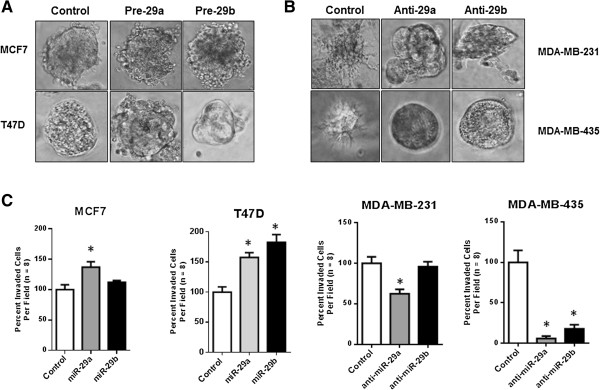Figure 2.

miR-29a/b enhance mesenchymal phenotype. (A) Breast cancer cells with significant epithelial phenotype MCF7 and T47D were treated with pre-miRNA HmiR0119-MR04 for 29a or HmiR0120-MR04 29b using transient transfection. The transfected cells were allowed to recover and were analyzed for their 3D structure. Fluorescence allowed for tracking only the colonies which grew from transfected cells. The 3D growth patterns were documented as photomicrographs using phase contrast microscopy. (B) Highly invasive breast cancer cells with noticeable mesenchymal phenotype MDA-MB-231 and Melanoma cells with highly invasive and mesenchymal phenotypes MDA-MB-435 were treated with anti-miRNA HmiR-AN0371-AM02 for 29a or HmiR-AN0373-AM02 for 29b using transient transfection. The transfected cells were allowed to recover and were analyzed for their 3D structure. Fluorescence allowed for tracking only the colonies which grew from transfected cells. The 3D growth patterns were documented as photomicrographs using phase contrast microscopy. (C) The same cells MCF7, T47D, MDA-MB-231 and MDA-MB-435 were transected by respective miRNA or antagomiRs as stated before and analyzed for their invasion using a modified Boyden chamber assay. The assay was performed for 16 hrs. Invaded cells were stained using crystal violet and enumerated. The results are represented as percent of control where the control is expressed as 100%. Error bars represent ± SEM and *indicates P ≤ 0.05
